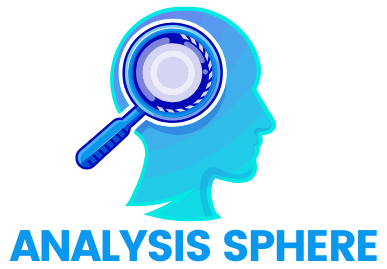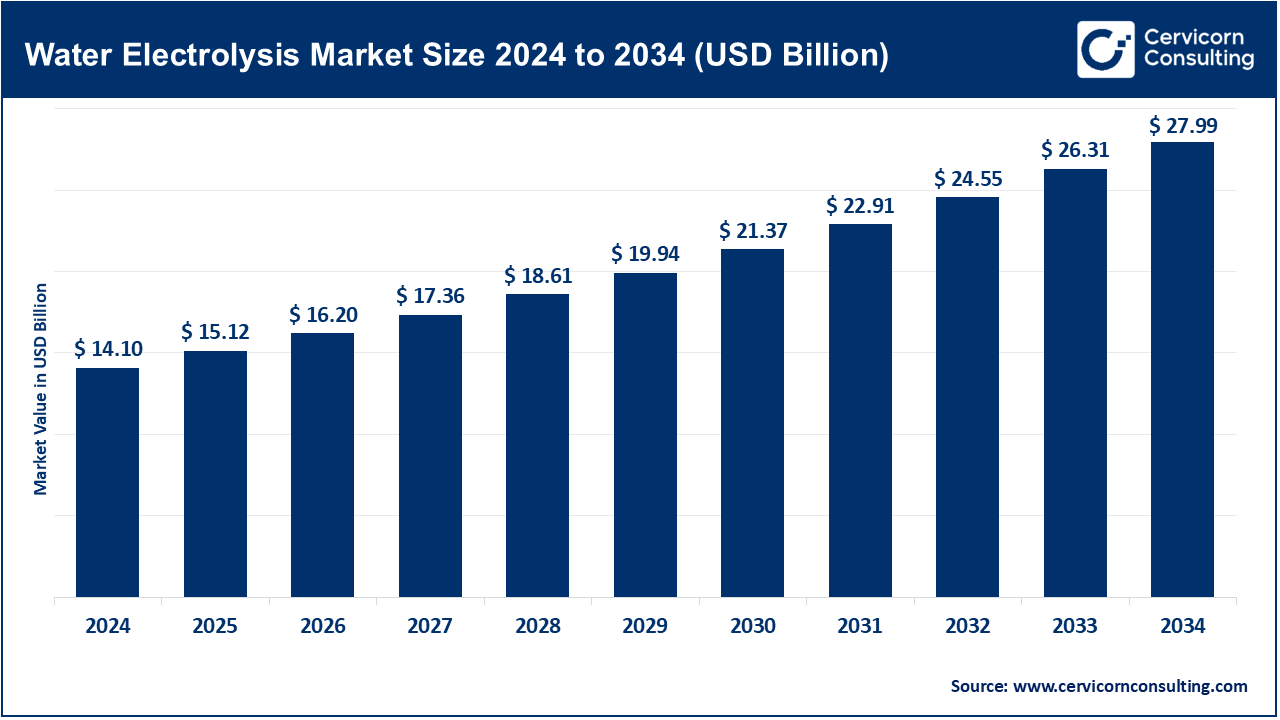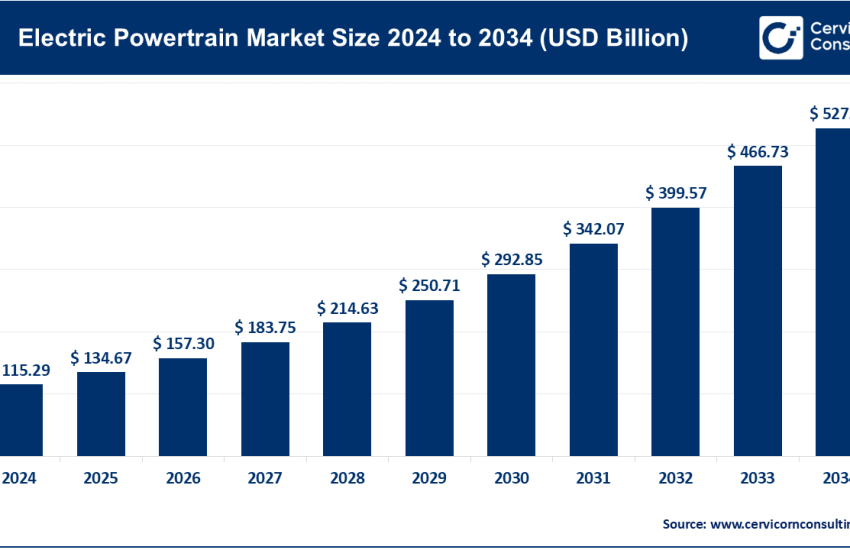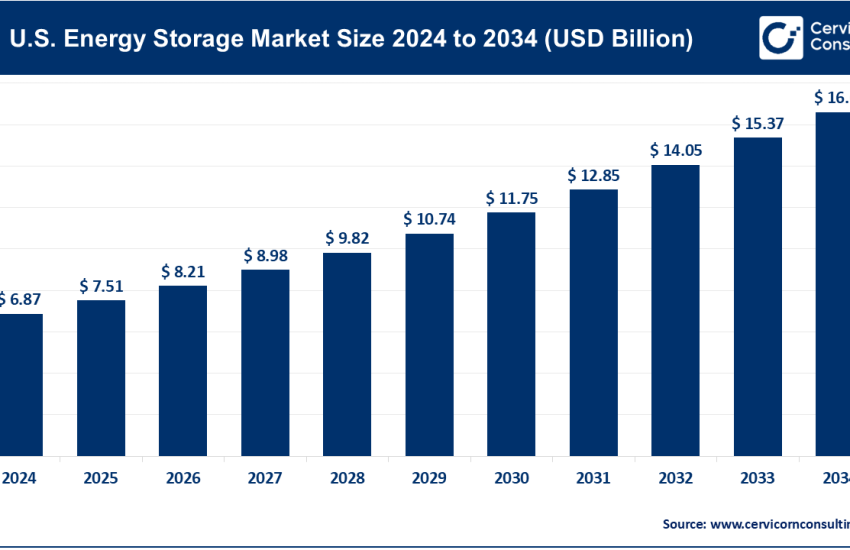Water Electrolysis Market Growth, Key Trends, Leading Players, and Market Forecast by 2034
Table of Contents
ToggleWater Electrolysis Market Growth
The global water electrolysis market size was valued at USD 14.10 billion in 2024 and is forecast to grow to approximately USD 27.99 billion by 2034. This represents a compound annual growth rate (CAGR) of 7.09% from 2025 to 2034. The growth of the market can be attributed to several key factors. The global push towards net-zero emissions by 2050 has led to increasing investments in hydrogen production technologies, with water electrolysis at the forefront. Government policies supporting the development of green hydrogen infrastructure, along with incentives for renewable energy projects, are accelerating market expansion.
Additionally, the declining costs of renewable energy, particularly solar and wind power, are driving the adoption of water electrolysis technologies. Technological advancements in electrolyzer efficiency and the development of larger-scale systems are improving the economic viability of green hydrogen production. Furthermore, the rise of the hydrogen economy, with a growing number of applications for hydrogen in transportation, industrial processes, and energy storage, is expected to further boost demand for water electrolysis systems.
What is the Water Electrolysis Market?
The Water Electrolysis Market refers to the sector involved in the production, development, and commercialization of systems and technologies that use water electrolysis to produce hydrogen gas. Electrolysis is a process that involves using electricity to split water into its basic components—hydrogen and oxygen. This is done using an electrolyzer, which consists of two electrodes, an anode, and a cathode, submerged in an electrolyte.
Water electrolysis, especially when powered by renewable energy sources like wind or solar power, is considered a green and sustainable method for hydrogen production, as it generates little to no carbon emissions. The market encompasses various types of electrolyzers, such as alkaline electrolyzers, proton exchange membrane (PEM) electrolyzers, and solid oxide electrolyzers, each offering different efficiencies, scalability, and applications.
Why is the Water Electrolysis Market Important?
The importance of the Water Electrolysis Market lies in its capacity to produce green hydrogen, which has the potential to revolutionize energy systems by serving as a clean fuel for industries, transportation, and power generation. Hydrogen is often considered a key solution in decarbonizing hard-to-abate sectors like steel production, chemical manufacturing, and heavy-duty transport, where electrification may not be feasible. The increasing global focus on reducing carbon emissions to combat climate change has put hydrogen at the center of clean energy discussions.
Additionally, water electrolysis offers a promising alternative to traditional hydrogen production methods, such as steam methane reforming, which rely on fossil fuels. As the world shifts towards renewable energy sources, water electrolysis enables the production of hydrogen with minimal environmental impact, facilitating the transition to a low-carbon economy.
Get a Free Sample: https://www.cervicornconsulting.com/sample/2324
Company Overview: Leading Players in the Water Electrolysis Market
- Nel HydrogenSpecialization: Nel Hydrogen is a global leader in the production of electrolyzers for green hydrogen production, specializing in both alkaline and PEM electrolyzer technologies. The company focuses on providing renewable hydrogen solutions to industries seeking to reduce their carbon footprint.
Key Focus Areas: Nel Hydrogen is committed to scaling up green hydrogen production and advancing electrolyzer technology. The company is focused on developing efficient, cost-effective electrolyzers and creating a comprehensive infrastructure for hydrogen supply chains.
Notable Features: Nel Hydrogen is known for its strong portfolio of electrolyzers used in industrial applications, offering solutions that are scalable, reliable, and sustainable.
2023 Revenue: Approximately USD 150 million.
Market Share: Nel Hydrogen holds a significant market share in the green hydrogen sector, particularly in Europe, where it has secured several high-profile projects.
Global Presence: The company operates globally with a strong presence in Europe, North America, and Asia.
- ITM PowerSpecialization: ITM Power is a leader in PEM electrolyzer technology, focusing on developing high-efficiency electrolyzers for hydrogen production.
Key Focus Areas: ITM Power is dedicated to scaling up PEM electrolyzer manufacturing and improving the efficiency of its products to reduce the cost of green hydrogen.
Notable Features: The company has established strong partnerships with major players in the energy sector, including Shell and Siemens, to advance the development of green hydrogen production facilities.
2023 Revenue: Around USD 75 million.
Market Share: ITM Power is one of the prominent players in the PEM electrolyzer market, with a growing presence in the UK and international markets.
Global Presence: ITM Power operates primarily in the UK, but has expanded its reach to Europe and other regions through strategic partnerships and joint ventures.
- Cummins Inc.Specialization: Cummins is a multinational corporation specializing in engine and power generation solutions, and it has expanded into the water electrolysis market by offering electrolyzers for hydrogen production.
Key Focus Areas: Cummins is investing heavily in the development of green hydrogen solutions through water electrolysis. The company is also focused on integrating electrolyzers into its energy solutions portfolio to support decarbonization.
Notable Features: Cummins has a significant presence in the global energy and automotive sectors, which gives it a competitive advantage in deploying electrolyzers for industrial and commercial applications.
2023 Revenue: Approximately USD 29 billion.
Market Share: Cummins has established a notable presence in the North American and global electrolyzer markets, with plans to expand further in the hydrogen sector.
Global Presence: Cummins operates in over 190 countries, making it one of the most geographically diverse companies in the water electrolysis market.
- Siemens EnergySpecialization: Siemens Energy focuses on the integration of sustainable energy technologies, including water electrolysis systems for green hydrogen production.
Key Focus Areas: The company is focused on decarbonizing the energy sector by providing advanced electrolyzers, as well as promoting the development of hydrogen infrastructure.
Notable Features: Siemens Energy combines its deep expertise in power generation and renewable energy to provide integrated solutions that include electrolysis and hydrogen production.
2023 Revenue: USD 24.2 billion.
Market Share: Siemens Energy holds a strong market share in the global energy sector, with increasing investments in hydrogen technologies.
Global Presence: Siemens Energy operates worldwide, with a particularly strong footprint in Europe, North America, and Asia.
- ABB Ltd.Specialization: ABB is a global leader in automation and electrification, and it offers electrolyzer solutions for green hydrogen production.
Key Focus Areas: ABB is concentrating on the integration of water electrolysis into industrial and commercial hydrogen production systems, focusing on sustainability and energy efficiency.
Notable Features: ABB has developed strong capabilities in automation and control systems for electrolyzers, which enhances the efficiency and reliability of hydrogen production.
2023 Revenue: USD 28 billion.
Market Share: ABB is a recognized player in the water electrolysis market, with significant market share in Europe and North America.
Global Presence: ABB has a global presence, serving customers in over 100 countries across various sectors.
Water Electrolysis Market Leading Trends and Their Impact
- Technological Advancements in Electrolyzer EfficiencyThe development of more efficient electrolyzers is one of the key trends in the water electrolysis market. Improvements in both PEM and alkaline electrolyzers are making hydrogen production more cost-competitive. The goal is to reduce energy consumption during electrolysis, which can drive down the cost of green hydrogen.
- Integration with Renewable Energy SystemsThe coupling of electrolyzers with renewable energy sources, such as solar and wind power, is a leading trend. This integration not only enhances the sustainability of hydrogen production but also ensures that hydrogen production is powered by green electricity, making it a truly clean energy source.
- Government Support and Policy DevelopmentGovernments worldwide are implementing supportive policies and providing incentives to encourage hydrogen production through electrolysis. These include grants, tax incentives, and infrastructure investments, all of which are vital for the market’s growth.
- Large-Scale Projects for Green Hydrogen ProductionIncreasingly, companies are pursuing large-scale green hydrogen projects to meet rising demand, particularly in industries like transportation and manufacturing. These projects are expected to contribute to the scaling of water electrolysis technologies, driving down costs and increasing efficiency.
Successful Examples of Water Electrolysis Market Around the World
- The HyNet Project (UK): A green hydrogen project in the UK that utilizes water electrolysis to produce hydrogen for industrial applications and transportation. It is backed by government funding and aims to decarbonize the heavy industry sector.
- REFHYNE (Germany): One of Europe’s largest green hydrogen projects, this plant uses water electrolysis to produce hydrogen, primarily for industrial use. The project is a collaboration between Shell, ITM Power, and Siemens Energy, showcasing the scale at which electrolyzers can be deployed.
- H2Future (Austria): A large-scale hydrogen production facility focused on producing green hydrogen through water electrolysis to support the decarbonization of the steel industry. It is a prime example of water electrolysis being integrated into industrial applications.
Regional Analysis: Government Initiatives and Policies Shaping the Market
- Europe: The European Union has set ambitious targets for hydrogen production as part of its Green Deal, with several member states offering financial incentives for green hydrogen projects. Germany, the UK, and the Netherlands are leading the charge with large-scale initiatives focused on decarbonizing industries through hydrogen.
- North America: In the United States, the Department of Energy has allocated significant funds to support hydrogen research and production. The country is also home to several major water electrolysis projects, including the DOE’s Hydrogen Energy Earthshot initiative, which aims to reduce the cost of hydrogen production.
- Asia: Japan and South Korea are heavily investing in hydrogen technologies, with a particular focus on fuel cell vehicles and industrial hydrogen production. These countries are expected to continue expanding their hydrogen infrastructure, including the integration of water electrolysis systems.
To Get Detailed Overview, Contact Us: https://www.cervicornconsulting.com/contact-us
Read Report: Sustainable Aviation Fuel Market: Growth Projections, Key Trends, and Regional Insights to 2033



